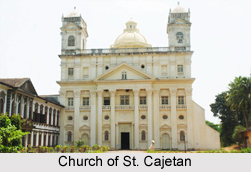 Old Goa is known to be a UNESCO world heritage site and is graced by palatial buildings and churches. The Archeological Survey of India is responsible for maintaining most of these remaining buildings and churches. The Archdiocese of Goa is responsible for the church services. The Church of St.Cajetan is one such church, located in the Indian state of Goa. More specifically, this Church is located in Old Goa near the Se Cathedral church and is also quite close to the ruins of the Viceregal Palace. It was earlier known as the Church of Our Lady of Divine Providence. Although the church is dedicated to Our Lady of Divine Providence, it has been named after St. Cajetan, the founder of the Order of Theatines and a contemporary of St Francis Xavier.
Old Goa is known to be a UNESCO world heritage site and is graced by palatial buildings and churches. The Archeological Survey of India is responsible for maintaining most of these remaining buildings and churches. The Archdiocese of Goa is responsible for the church services. The Church of St.Cajetan is one such church, located in the Indian state of Goa. More specifically, this Church is located in Old Goa near the Se Cathedral church and is also quite close to the ruins of the Viceregal Palace. It was earlier known as the Church of Our Lady of Divine Providence. Although the church is dedicated to Our Lady of Divine Providence, it has been named after St. Cajetan, the founder of the Order of Theatines and a contemporary of St Francis Xavier.
History of Church of St. Cajetan
History highlights that Pope Urban VIII had sent three Italians of the Order of Theatines to the kingdom of Golconda (near Hyderbad). They arrived in the kingdom with the aim to preach Christianity, in the year 1639. They were D. Pedro Avitabili, D. Francisco Marci and D. Antonio Maria Ardizone. The Theatines or the friar preachers were not permitted to work in Golconda. Therefore they started their journey towards Goa and arrived here on 25th October 1640. In 1643, the construction of a hospital was started by them in Goa, only to be halted on the commands of the local Viceroy. They were also asked to leave Goa in 1645. With the determination to establish the Church D. Pedro Avitabili, the leader of the group of Theatines, went to Portugal and explained the King, Dom Joao IV that, it would be in the interest of Christian religion if they were allowed to work in Goa together with the Portuguese priests. In 1650, the King being overwhelmed by Avitabili"s determination, granted permission to erect the hospital. The Theatines also received permission to build the Church and also a Convent. 1661 marks the year of complete erection of the Church of St. Cajetan. The Convent was also built around the same time, but was relatively much smaller in size and was expanded later.
Architectural Design of Church of St. Cajetan
The church is almost a replica of Basilica of St. Peter located in Rome. The architecture of the Church of St. Cajetan is of Corinthian style. Its interior is a blend of mosaic-Corinthian architectural pattern. The church has been constructed using laterite blocks and has been plastered with lime. The St Cajetan Church has a total of seven altars. The golden altars with beautiful carvings are of Baroque style. Inside the church there are three altars towards the left which are dedicated to the Holy family of Our Lady of Piety and St. Clare. On the right the altars of St. Cajetan, St. John and St. Agnes are situated. The largest of the altars on the right hand side of the church is dedicated to St Cajetan. The devotees need to ascend the spiral staircase of about 50 steps before entering the church. The church is actually vaulted. A wooden platform emerges from one of the docks and is beautifully adorned and decorated. Underneath the dome there is a well which remains with a square slab. This has led the historians to speculate that there had been a Hindu temple before the construction of the Church over it. The remains of the doorway in the grounds of the Church was at one point of time the entrance to an Islamic palace belonging to Adil Shah who was the ruler of Goa prior to the Portuguese rule here.
Surrounding of Church of St. Cajetan
There is presently a convent near the church that houses a functioning theological college called the Pius X Pastoral Institute, which was inaugurated on October 29th, 1962. The convent has been renovated and a new western wing has also been added to it. In the vicinity of the Church, there is also a building which housed the Theatine Monastery. This building is currently the setting for Diocesan Pastoral Centre.
Visiting Information
The transport facilities of Goa are of relevance to Church of St. Cajetan, as it is located in here. The Dabolim airport of Goa is well connected by flight with major cities in India. Madgaon, Vasco-da-Gama, Tivim and Karmali railway stations of Goa are well connected by trains with major cities and places in India. Panaji, Mapusa, Margao, and other main cities of Goa are well connected by motorable roads with different cities and places in India. St. Cajetan Church can be reached by hiring cabs, autos or buses from Panaji or any other nearby place in Goa.
Related Articles:
Churches in India
Churches and Convents of Goa
Architecture of Church of St. Cajetan
Churches of Old Goa
Church of St. Peter
St. Paul Church











